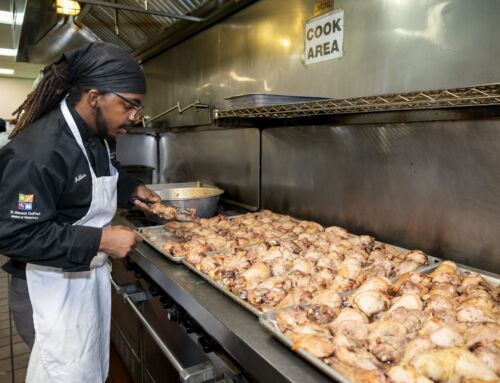
Could they program their robot to flush a toilet?
It was a wintry Saturday morning in February, and dozens of middle school boys and girls, their parents and siblings were breathlessly gathered in the West Side Middle School cafeteria in Waterbury for the FIRST® LEGO® League team competition.
Teams of students, intently willing their robots to control toilets, turn on water treatment plants, or remove barriers to waterfalls on a pre-designed course, had been preparing since October for the water- themed robotics competition.
During twice weekly after-school sessions organized by Waterbury Public School’s Supervisor of Science and Technology Education John Reed, teams of students at three Waterbury middle schools (North End, Wallace and West Side) and one alternative school (Enlightenment) had learned computer coding and logic in order to program robots.
They were also preparing for a future in which skilled workers in science, technology, engineering and math (STEM) will be in high demand. Nationally, disparities exist with access to and success in STEM subjects along racial, socioeconomic, gender, and geographic lines, as well as among students with disabilities. The United States Department of Education, National Science Foundation and many others are urging educators to close the gaps. Waterbury Public Schools are taking many steps to educate their diverse student body in STEM skills, including the revival of their robotics program.
Enter Connecticut Community Foundation and a committed group of Waterbury educators led by Reed and administrator Louise Brown, a savvy group of teacher-coaches, and robotics teams from Kennedy and Crosby High Schools in Waterbury.
With salaries for teacher-coaches and registration fees funded by the Foundation, the robotics program has taken off—fed by the energies of 60 middle schoolers.
“We’re trying to give the kids as many opportunities as possible to experience hands-on, cool stuff so they say ‘wow, I can do this.’ A lot of them had never programmed, had never done anything like that. So robotics has given them the confidence, exposure and fun. They see that it’s a blast to do this,” said Reed.
The February robotics face-off was lively and competitive, and the teams often applauded each other’s efforts.
According to Reed, “Sportsmanship is as important as having a successful robot. Are you helping other schools? Are you open to sharing parts if something breaks?”
“It’s so much more than robotics,” he said. “It also really helps build the soft skills that they say kids are lacking for jobs, where they have to work and problem-solve together. [During the competition], if something went wrong, they would put their heads together. And that’s a huge step forward for middle school kids to be able to do that.”
In Reed’s experience with robotics teams, the experiences stick.
“When you follow these kids up through the high school level, you’d be amazed that almost all at that point want to be engineers….They expressed some kind of interest in a STEM career, and many said they wouldn’t have chosen that if they hadn’t had the chance to build and code robots and compete against other teams.”
Photo: The FIRST® LEGO® League team competition at West Side Middle School in Waterbury.







